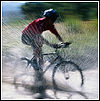 This Is Easy!
This Is Easy!
 eaving a wheel to be trued by bike shop can be expensive.
One can true a wheel quite easily. eaving a wheel to be trued by bike shop can be expensive.
One can true a wheel quite easily.
Truing prodecure
Ideally, wheels should be true laterally (no
wobbles) and vertically (no hops or flat spots). Lateral truing is easier and, in most
cases, more important.
1. Spin the wheel slowly and watch for lateral
movement relative to the reference points. Initially, it's helpful to mark the wobbles by
holding a felt tip marker against one of the reference points.
2. Wiggle each spoke to find loose ones. Mark them
or apply a piece of tape so they can be found later. It's likely that the loose spokes are
near your rim marks.
3. Rotate the wheel so the loose spoke is at the
truing stand's reference arms. Turn the nipple counterclockwise one-half turn at a time
until it feels as tight as the other spokes when you wiggle it. (It's easy to get confused
and turn the spoke nipple the wrong way. To prevent this, always bring nipples to the same
position near the stand's arms at the bottom of the wheel before making adjustments. In
this position, counterclockwise turns, as viewed from above, will tighten the spokes and
clockwise turns will loosen them.) Repeat for the other loose spokes.
High quality wheels are strong and durable because
the spokes are evenly tensioned. While this is difficult to master quickly without a
special, relatively expensive tool called a spoke tensiometer, adequate strength can be
achieved by developing a feel for optimum tension and ensuring that there are no extremely
loose spokes. If you spin the wheel now, you should notice that it's not quite as wobbly.
Tightening the loose spokes made it straighter.
4. The next step is more truing to minimize lateral
movement. This takes patience. Always adjust nipples a half turn at a time and spin the
wheel to check progress. It may look like nothing happened, but if you keep working the
wheel will improve.
On every wheel there are right-side and left-side
spokes. At the rim, the spokes are staggered to each side. The easiest way to tell which
is a right or left spoke is to look at which hub flange it attaches to.
If you need to move a section of the rim to the
left, you can tighten spokes leading from it to the left hub flange, loosen spokes leading
to the right hub flange, or do a little of each. Always feel for loose or tight spokes at
the wobble, and take this into account when deciding what to do. Usually, tension
differences correspond to the wobble in the rim, and correcting them should result in
quick alignment. This may only require adjusting two to four nipples. Always strive for
even tension.
Important: Keep in mind that the right spokes in a
rear wheel are always tighter than those on the left due to rear wheel "dish." (
Because of the space occupied by the freewheel, the rim must be closer to the right hub
flange than the left in order to be centered in the frame.) Still, the spokes going to
each flange should be equally tensioned among themselves.
True the largest wobble (the longest mark), then
move to the next trouble spot. For instance, if the mark is on the right side of the rim,
that part of the rim needs to move to the left. If the spokes feel evenly tensioned,
loosen the right-side spokes in this area one half-turn and tighten the left-side spokes
one half-turn. Check the result. Try to tighten or loosen several spokes at a time, and
avoid using one spoke to pull the rim into true. Continue working until all wobbles are
gone.
5. Eliminating vertical movement (putting a wheel
into "round") may be more difficult. Spin the wheel and look for vertical
movement relative to the reference arms. (The tire and tube must be removed.) Again, mark
the problem spots. If the rim moves inward toward the hub (a "flat spot"),
slightly loosen four consecutive spokes in that area. If the rim moves away from the hub
("hop"), tighten four spokes in that area. After each set of adjustments, check
and correct for lateral movement. Keep in mind that it's normally not possible (or
essential) to make a used wheel completely round.
Also, perfect vertical or lateral alignment will be
impossible on your beat up practice wheel. When it's as good as possible, you might want
to loosen spokes at random and try truing it again. Then you'll feel confident enough to
work on your own wheels. |
![]()
